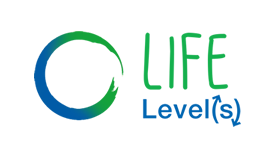About the project
What
The Life for LCA LCC Level(s) project (short: LIFE Level(s)) is directed towards mainstreaming sustainable buildings in Europe through greater awareness and use of the specified indicators within the framework of Level(s), a set of common European Union indicators to address life cycle environmental performance of buildings.
The key indicators within Level(s) are Life cycle assessment (LCA), Life cycle costing (LCC) and Indoor air quality (IAQ).
The Life for LCA LCC Level(s) project (short: LIFE Level(s)) has received funding from the LIFE Programme of the European Union. The project will last for three years, from 2019 until 2022.
The partners engaged in the execution of the project and implementation of its outcomes are 8 European Green Building Councils, recognised for their contribution in spreading the awareness about green building principles and promotion of environment protection and energy efficiency values.
Why
The European Union is increasingly investing in the recognition of the importance of buildings sector, circular economy and environment policy. The buildings sector in the EU accounts for 36% of all emissions; 50% of energy consumption; 50% of all raw material extraction; 1/3rd of all waste and water usage and 18 million construction jobs.
Considering that people spend 90% of their time indoors, indoor air quality is just as critical as poor air quality, and its effects on people’s health.
Therefore, the European Commission is devoted to tackle the issues of energy and climate through initiatives such are Circular Economy Action Plan, Energy Performance of Buildings Directive and the EU 2050 strategy.
Nevertheless, a life cycle approach to greenhouse gas emissions and resource needs to be more recognised in order to help the building sector reduce the total environmental impacts of the buildings they invest in, design, build, occupy and deconstruct.
In line with that, the European Commission created Level(s): a framework of common EU indicators to address life cycle environmental performance of buildings. Level(s) aims to be the foundation of Europe’s future sustainable building policy and stimulate awareness raising.
The main idea of Life for LCA LCC Level(s) project is to mainstream sustainable buildings in Europe through greater awareness and use of the specified indicators within the framework of Level(s), such are Life cycle assessment (LCA), Life cycle costing (LCC) and Indoor air quality (IAQ).
Goals
The main goal of LIFE Level(s) project is to mainstream sustainable buildings in Europe through greater awareness and use of the indicators within the Level(s) framework. According to previous experience, it is challenging for most European companies to apply the indicators within Level(s) such are LCA, LCC and IAQ, due to a lack of data and a lack of expertise in the industry.
For that reason, the idea behind the LIFE Level(s) project is to work with stakeholders form the public, private and certification schemes to explore how the mentioned key Level(s) indicators can be implemented on a pan-European scale.
Another objective is achieving the greater sense among the main actors in the industry and government on the necessity of Level(s) and a lifecycle approach framework in addressing climate environmental risk.
Also, the conditions for alignment of Europe's leading green building certification schemes with Level(s) would be possible through building the capacities of stakeholders across the whole sector, integrating the public authorities in order to align Green Public Procurement (GPP) criteria with Level(s) and identifying necessary administrative and data requirements.
The overlapping goal is to generate awareness across the industry and government on the necessity of Level(s) and a life cycle approach framework in addressing climate and environmental risk.
What is Level(s)?
Level(s) is a voluntary reporting framework to improve the sustainability of buildings. Using existing standards, Level(s) provides a common EU approach to the assessment of environmental performance in the built environment.
Within the Level(s) framework, each indicator is designed to link the individual building’s impact with the priorities for sustainability at the European level. This focuses the Level(s) user on a manageable number of essential concepts and indicators at building level that contribute to achieving EU and Member State environmental policy goals.
Level(s) - aims to unite the whole sector value chain around a common European language for better building performance. It looks at the full lifecycle of buildings to address their huge potential for emissions reductions, efficient and circular resource flows, and supporting the health and wellbeing of those they are built to serve.
Level(s) will serve as a galvanising force for actors across Europe's building sector in understanding how they can collaborate to create a sustainable built environment for all Europeans.
Level(s) is a tool for designing and constructing sustainable buildings. Sustainable buildings use less energy and materials, and are healthier and more comfortable spaces for occupants.
Importance
The acquirement of goals such are raising the awareness on the necessity of Level(s), aligning Green Public Procurement criteria with Level(s), building the capacities of stakeholders across the whole sector to apply the Level(s) indicators and aligning Europe’s leading green building certification schemes with Level(s), will become the first step in creating the needed conditions which will enable European construction sector stakeholders to mainstream Level(s).
The significance of the project lies within its approach towards hundreds of potential collaborators from various sectors such as industry, governments and public sector and non-governmental organizations with an encompassing purpose of creating a foundation for the development of future European and national sustainable development policies, improvement of environmental and climate performances and creation of positive socio-economic shifts.
